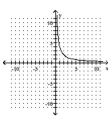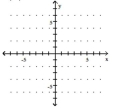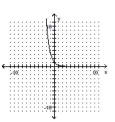A) Yes
B) No
Correct Answer

verified
A
Correct Answer
verified
Multiple Choice
Solve the equation. -
A) 2, -1
B) -1
C)
D) 2
Correct Answer

verified
Correct Answer
verified
Multiple Choice
Evaluate. -
A) 11.2
B) 1.12
C) 3.2900
D) 112
Correct Answer

verified
Correct Answer
verified
Multiple Choice
Graph the function.
-

A) ![]()
B) ![]()
C) ![]()
D) ![]()
Correct Answer

verified
Correct Answer
verified
Multiple Choice
A one-to-one function f is given. and graph fwith a solid line and with a dotted line on the same axes.
-
![A one-to-one function f is given. \text { Find } \mathrm { f } ^ { - 1 } ( \mathrm { x } ) and graph fwith a solid line and f ^ { - 1 } ( x ) with a dotted line on the same axes. - f ( x ) = x ^ { 3 } + 1 A) f ^ { - 1 } ( x ) = - \sqrt [ 3 ] { x - 1 } B) f ^ { - 1 } ( x ) = \sqrt [ 3 ] { x - 1 } C) f ^ { - 1 } ( x ) = - x ^ { 3 } + 1 D) f ^ { - 1 } ( x ) = - x ^ { 3 } - 1](https://d2lvgg3v3hfg70.cloudfront.net/TB8419/11edfd4b_88c3_0526_9c63_a3e21550a90d_TB8419_00.jpg)
A) ![]()
B) ![]()
C) ![]()
D) ![]()
Correct Answer

verified
Correct Answer
verified
Multiple Choice
Solve the equation without using a calculator. -
A) 2
B) -2
C) 13
D) 12
Correct Answer

verified
B
Correct Answer
verified
Multiple Choice
A one-to-one function f is given. and graph fwith a solid line and with a dotted line on the same axes.
-

A) ![]()
B) ![]()
C) ![]()
D) ![]()
Correct Answer

verified
Correct Answer
verified
Multiple Choice
Evaluate. -
A) -3
B) 49
C) -49
D) 3
Correct Answer

verified
Correct Answer
verified
Multiple Choice
Solve the equation. -
A) 96
B) 512
C)
D) 2.7093
Correct Answer

verified
Correct Answer
verified
Multiple Choice
Solve the equation. -
A) 7
B)
C) 7, -2
D) -2
Correct Answer

verified
Correct Answer
verified
Multiple Choice
Find the value obtained when 10 is raised to the given exponent. Round to three significant digits. --1.4375
A) 27.4
B) -0.0365
C) 0.0365
D) -27.4
Correct Answer

verified
Correct Answer
verified
Multiple Choice
Determine whether the function is a one-to-one function. -
A) Yes
B) No
Correct Answer

verified
Correct Answer
verified
Multiple Choice
Solve the equation without using a calculator. -
A) 2
B)
C)
D) -2
Correct Answer

verified
Correct Answer
verified
Multiple Choice
Graph the function.
-

A) ![]()
B) ![]()
C) ![]()
D) ![]()
Correct Answer

verified
Correct Answer
verified
Multiple Choice
Find the antilog of the logarithm. Round the answer to six decimal places. --1.4972
A) 4.469158
B) 31.419553
C) 0.708402
D) 0.031827
Correct Answer

verified
Correct Answer
verified
Multiple Choice
Use properties of logarithms to expand the logarithmic expression as much as possible. -
A)
B)
C)
D)
Correct Answer

verified
Correct Answer
verified
Multiple Choice
Determine whether the given function is one-to-one. If it is one-to-one, find its inverse function. -
A)
B)
C)
D) not a one-to-one function
Correct Answer

verified
Correct Answer
verified
Multiple Choice
Determine whether the function is a one-to-one function.
-
A) Yes
B) No
Correct Answer

verified
A
Correct Answer
verified
Multiple Choice
For the given functions f and g , find the indicated composition. -
A)
B) 10x + 63
C) x
D) x + 14
Correct Answer

verified
Correct Answer
verified
Multiple Choice
Solve for the indicated variable. -
A)
B)
C)
D)
Correct Answer

verified
Correct Answer
verified
Showing 1 - 20 of 229
Related Exams